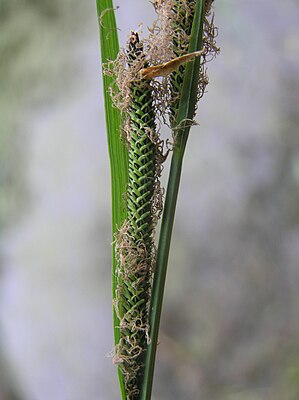Banat sedge
| Banat sedge | ||||||||||||
|---|---|---|---|---|---|---|---|---|---|---|---|---|

Banat sedge ( Carex buekii ) |
||||||||||||
| Systematics | ||||||||||||
|
||||||||||||
| Scientific name | ||||||||||||
| Carex buekii | ||||||||||||
| Wimm. |
The Banat sedge ( Carex buekii ) is a species of the genus Sedges ( Carex ). It is common in Europe.
description
Vegetative characteristics
The Banat sedge is a perennial herbaceous plant and reaches heights of 45 to 90, rarely up to 120 centimeters. It forms elongated runners . The stems are sharp triangular and very rough on top. The leaves are up to 10 mm wide on non-flowering shoots and curl down as they dry. The basal sheaths are spideless, red-brown to black-brown and frayed with a strong network.
Generative characteristics
The flowering time is in April and May. The Banat sedge is a variegated sedge. The male and female spikelets are different, but all slender cylindrical. The lower spikelets in particular are distant. There are one to three male and three to five female spikelets. The female spikelets are up to 10 centimeters long, have a short stalk, stand upright and later hang over. The lowest bract is leaf-like and longer than its spikelet, but shorter than the entire inflorescence .
The bracts of the female flowers are blackish and have a green central stripe. They are elongated and blunt, shorter than the fruit. The stylus has two scars .
The green, bare fruit is 2 mm long, veinless, flat on the inside, arched on the outside and has a very short beak.
Occurrence
The Banat sedge occurs from Central Europe to the Caucasus. The main distribution area of the Banat sedge is in south- eastern Europe and in the eastern Mediterranean , and it extends from there eastward to Kazakhstan . It is a submeridional to subtemperate, subcontinental flora element .
In Central Europe it occurs only sporadically in Saxony-Anhalt , in Saxony (for example in the Elbe valley near Dresden ) on river banks; it is rare in the Bavarian Forest in Lower and Upper Austria.
It grows in a very warm summer climate on river banks and riparian forests. The Banat sedge thrives best on loose, base-rich, often slightly boggy, loose-sand or fine-gravel soils with groundwater flowing through them . It is a character species of the Caricetum buekii from the Magnocaricion association.
supporting documents
- Rudolf Schubert , Klaus Werner, Hermann Meusel (eds.): Excursion flora for the areas of the GDR and the FRG . Founded by Werner Rothmaler. 13./14. Edition. tape 2 : vascular plants . People and knowledge, Berlin 1987, ISBN 3-06-012539-2 .
- Siegmund Seybold (Ed.): Schmeil-Fitschen interactive . CD-ROM, version 1.1. Quelle & Meyer, Wiebelsheim 2002, ISBN 3-494-01327-6 .
Individual evidence
- ↑ Rafaël Govaerts (ed.): Carex buekii. In: World Checklist of Selected Plant Families (WCSP) - The Board of Trustees of the Royal Botanic Gardens, Kew . Retrieved October 18, 2016.
- ↑ a b c Dietmar Aichele, Heinz-Werner Schwegler: The flowering plants of Central Europe . 2nd Edition. tape 5 : Swan flowers to duckweed plants . Franckh-Kosmos, Stuttgart 2000, ISBN 3-440-08048-X .
- ^ Erich Oberdorfer : Plant-sociological excursion flora for Germany and neighboring areas . With the collaboration of Angelika Schwabe and Theo Müller. 8th, heavily revised and expanded edition. Eugen Ulmer, Stuttgart (Hohenheim) 2001, ISBN 3-8001-3131-5 , pp. 183 .
Web links
- Banat sedge. In: FloraWeb.de.
- Banat sedge . In: BiolFlor, the database of biological-ecological characteristics of the flora of Germany.
- Profile and distribution map for Bavaria . In: Botanical Information Hub of Bavaria .
- Thomas Meyer: Data sheet with identification key and photos at Flora-de: Flora von Deutschland (old name of the website: Flowers in Swabia )
- Photos: [1] , [2]